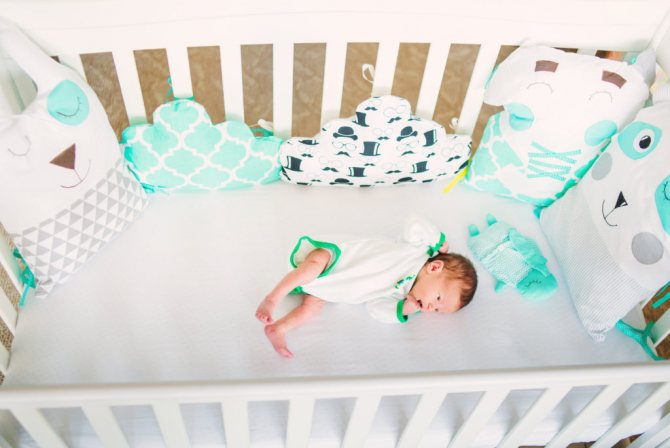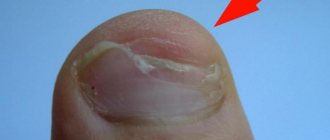Some babies cannot sleep in their cribs, so parents need to learn in advance how to wean their baby from falling asleep in their arms. It is recommended to understand the difference between communicating with a newborn and developing negative habits. You can pick it up and rock it to sleep, but you shouldn’t constantly hold the baby in your arms - he will quickly get used to it and will not fall asleep on his own.
Everyone in the family needs rest
Do I need to rock my baby to sleep?
Young parents are increasingly refusing to rock their newborns and infants. However, pediatricians claim that this opinion is erroneous and recommend such skin-to-skin contact for babies, especially those under 1 year old. Supporters support them, but opponents cite as the main argument the fact that later the problem will arise of how to wean a child from rocking in his arms.
Lulling is an ancient way to quickly calm a baby. But is it worth doing this? Experts are sure: rhythmic rocking in the arms or in a stroller allows a newborn to feel comfortable and calm . In addition, the process serves as training for the baby’s vestibular apparatus.
But there are people who are sure that frequent rocking causes sleep disturbance, and the poor development of the vestibular system of children causes fainting, which inexperienced parents confuse with deep sleep.
Why does a baby sleep better in your arms?

But he feels safe in his mother’s arms. Not knowing how to wean the baby from rocking in his arms, parents begin to look for the reasons why the baby falls asleep only in this position.
A common cause is considered to be increased restlessness and anxiety experienced by the baby. And in the arms of his father or mother, he feels protected, calms down and falls asleep.
Maintaining tactile communication in this way is especially important in the first months of his life. But do not overdo it, because this causes addiction to falling asleep in your arms and problems with the development of the vestibular apparatus.
Pediatricians explain this feature by the fact that the baby was in the mother’s womb for 9 months, dependent on her warmth, feeling one with her. And after birth, he experiences stress and discomfort, needing a new, no less safe and cozy “nest” that can pass for his mother’s hands.
How to wean a one-year-old child from motion sickness: problems
Some children get used to the surrounding reality quite easily, and they do not need to be weaned from motion sickness. They perceive changes in the regime completely calmly, therefore, after staging small protests in the form of crying for several days, they fall asleep on their own in their crib. However, most babies do not want to fall asleep without being rocked to sleep. They begin to be capricious and scream for a long time, that is, they make attempts to attract attention to themselves so that their mother will take them in her arms. The explanation for this behavior is quite simple - they are accustomed to their mother’s hands, smell, and heartbeat. And if they are suddenly deprived of this, they feel unprotected. Therefore, it is advisable to wean off gradually and it is better to start this process at an earlier age, since the older the child gets, the more difficult and painful it is to do this.
Benefits and harms

When thinking about how to wean a child from rocking before bed, parents think about the advantages and disadvantages of this method of soothing.
Rocking to sleep is one of the important aspects of overall development, because during it the newborn interacts with its parents, receiving their warmth and affection.
There are several advantages:
- Scientists have confirmed that children who were deprived of close contact with their mother in infancy grow up shy and unsociable. Most often, they are not able to stand up for themselves, finding themselves the object of ridicule. As a result of this, their self-esteem decreases, and as they get older, they begin to take revenge on others. Therefore, carrying it in your arms before bed is not only possible, but also necessary.
- This is an effective opportunity to restore the close bond that was established between mother and newborn during pregnancy. After all, while being lulled to sleep, the baby gets the feeling that he is in the womb, where he was calm and comfortable . And smooth and rhythmic movements help to relax the baby and ensure his complete calmness, necessary for the mood for relaxation.
- When cradled in your arms, babies are distracted from the painful sensations that arise from colic or teething.
- Lullaby movements help in a few minutes to calm down a crying and capricious newborn, even in a very overexcited state after active games.
When analyzing these arguments, it becomes clear that lulling during communication or before bed is a component of caring for infants. However, you should not overdo it, so as not to encounter difficulties in falling asleep on your own in the future.
From this publication you will find out whether a newborn can sleep on his stomach and how dangerous sudden death syndrome is in this sleeping position.
There are also disadvantages:
- Before going to bed, you have to be constantly present. But children who are accustomed to falling asleep on their own can fall asleep to a cartoon, a quiet melody, or a quiet game with toys.
- Over time, many babies become accustomed to this method of soothing and putting them to sleep. Therefore, it can be extremely difficult for parents to wean their baby from this ritual.
- Some children realize that adults can easily be manipulated in this way, and begin to demonstrate their character more often, refusing to fall asleep without the usual lulling.
- It is much more difficult to hold a one-year-old baby in your arms than a newborn, because he rapidly gains weight and becomes heavy.
How to stop a child from falling asleep in your arms?
What is the right thing to do in such a situation? Will you have to sleep sitting up, give up rest, the basic need to take a warm bath, have lunch sitting at the table, in order to constantly rock the baby? This is a real test, given that the little one is growing and gaining weight.
In order for the baby to fall asleep peacefully, ensure that the need for communication and contact with the mother during the daytime is met in accessible ways.
Experienced specialists and parents share tips in effective ways:
- When the baby is awake during the day, use a sling. This will help relieve your back, spine, and free your hands.
- An effective event is a joint vacation. Child psychologists advise placing a crib next to an adult. This way, the baby will fall asleep faster, feeling safe, and the quality of sleep will be better.
- Infants are swaddled before going to bed. Fixed arms and legs pressed tightly to the body give the feeling of being in the womb. The child goes into hibernation faster, sleeps more soundly, and wakes up less often.
- If during the night's rest children often wake up, are capricious, scream, or do not want to sleep, make adjustments to the daily routine. Try to shorten and cancel the day's rest temporarily. The baby will settle down faster in the evening. Do not overload your baby emotionally or physically during the day.
Buy a comfortable crib made from natural materials. Pay attention to bedding and sleepwear sets. To quickly get used to it and adapt to sleeping in a new place, put your thing there. A familiar smell will help you fall asleep faster and sleep more soundly.
To help your baby learn to settle down on his own, teach him not to be afraid of the dark. Curtain the windows during the daytime rest. The baby will develop a relationship between darkness and sleep.
Rocking and rocking should not be used at any opportunity. Babies instantly get used to them and stop falling asleep without such rituals.
How to wean your baby from motion sickness before bed

He will behave calmly if he feels the familiar smell and warmth of his mother. There are effective ways to wean off motion sickness: 1 Falling asleep on the mother's chest. The method is great in the first months of a baby’s life, but has one drawback: when weaning, children often wake up. 2 Co-sleeping. The baby feels a familiar smell and warmth, so he calmly falls asleep. 3 Sequence of actions. This is an effective method for teaching a child to fall asleep without motion sickness. It consists of performing the same actions every day before sleep (ritual). 4 Warm bath. An equally effective way to wean your baby from motion sickness before bed. Usually a collection of soothing and relaxing herbs is added to it. A bath from the string has a calming and antiseptic effect. 5 Falling asleep alone. It is necessary to transfer the baby to the crib as soon as the first signs of sleep appear and leave the room. If you hear crying, you should not react to it for several minutes. Usually within a moment the child is fast asleep. How to teach a child to sleep in his own crib is the topic of this article. 6 White noise. There are many devices that produce quiet and uniform sounds that lull a newborn to sleep. 7 Creating a cozy nest. You need to make a place out of a blanket or blanket that resembles a cocoon , which will limit the space and provide a feeling of comfort. 8 Being nearby. This is another method of how to put a baby to bed without motion sickness, but it is only suitable for persistent mothers. You need to wait until the first signs of falling asleep begin to appear. Then the baby needs to be placed in the cradle and stood next to him, preventing him from crying. At the same time, you cannot look into his eyes or touch him: you can only rock the crib or hum a song.
If a child cries for a long time, the problem can be solved not only by pumping. Herbal teas will help your newborn calm down.
When to start: how to wean your child from rocking in your arms
It should be understood that any change in already established habits is a great stress for the baby. The same applies to motion sickness: if a child is used to falling asleep only this way, then he needs to be weaned off gradually. Experts recommend starting no earlier than 6–8 months: for children under six months old this is too much stress. But you shouldn’t delay it either: if you don’t stop this habit until the baby is one year old, then teaching your child to fall asleep on his own will be much more difficult.
The main rule is not to rush. Psychologists recommend dividing the process into two stages: first weaning the baby from holding hands, and only then from motion sickness. Before going to bed, put your baby in the crib and rock him in it. When the baby gets used to his sleeping place, you can try to stop rocking him to sleep and teach the baby to fall asleep on his own.

After six months, you can try to teach your baby to fall asleep on his own. Parents have six months to put their plan into action
There are several ways by which you can wean your child from motion sickness in your arms.
- Let your baby know that you are not abandoning him and that you are with him all the time. To do this, pick him up more often during the day, during games or walks in the fresh air. If mother and baby prefer a sling or ergo backpack to a stroller, great: the child will be in close contact with one of the parents most of the time. By the evening, when it’s time to go to bed, the baby will not feel that he lacks his mother’s care.
- Teach your child to certain rituals: reading fairy tales before bed, swimming with toys in cool water and eating a hearty dinner before bed. During the day, play actively with your baby so that he gets tired. An exhausted baby who has taken a bath and felt a relaxing massage will easily and quickly fall asleep under his mother’s voice.
- If your financial capabilities allow, you can purchase a rocking chair or an electric swing that will lull the baby to sleep without any visible effort on the part of the parents. As soon as the baby gets used to being held, the time of rocking in these devices can be gradually reduced. Later, the baby will get used to falling asleep without rocking at all.
- Many children sleep on the street. But instead of rocking your baby to sleep in your arms, opt for a stroller. Roll your baby in it until he falls asleep.
- Equip your baby's sleeping place in such a way that he only wants to sleep there. Choose bedding with his favorite characters, place next to him the best toy that the baby constantly plays with. Something with mom's scent also helps.
- Let your child know that you are also staying close to him. At first, move the baby crib close to the adult one, you can even remove the sides on one side. Gradually, the baby will get used to sleeping on his own and the crib can be moved to the other end of the room.
- Leave the night light on at night: if the baby wakes up, he should see that his parents are in the same room with him. Often children, seeing mom or dad, fall asleep on their own within a few minutes.
Parents should remember that the process of weaning from motion sickness will take place with the whims of the child. You cannot retreat, because the baby will understand that parents can be manipulated and next time it will be even more difficult to start trying. Patience and calm are the keys to a successful process. You can’t scold the baby or shout at him. It is recommended to calmly and affectionately explain to the child that he is already big and all children sleep in their own beds and fall asleep without their mother’s hands.
How to teach a child to fall asleep on his own - video
When to put off learning to fall asleep on your own
Parents who are faced with the problem of getting their child to fall asleep on their own often think about how to wean their child from rocking to sleep before bed, without taking into account the fact that in some cases it is necessary to delay weaning from this method of soothing. Such situations include:
- diseases;
- colic;
- bloating;
- elevated body temperature (see review of temperature suppositories for children);
- the period when teeth are being cut.
You should not try to take any measures to wean yourself from pumping when signs of illness appear. During this period, the child will still cry and be capricious, and you can calm him down only by lulling him to sleep.
If a child suffers from colic, then medications and therapeutic massage will help solve the problem (they are discussed in this review and in the article at the link). Rocking him to sleep will only calm him down temporarily. If a child is tormented by gas emissions, then the use of a gas outlet tube can radically help in solving this problem.
Alternative methods for putting your baby to sleep

Alternative methods of putting the baby to sleep without rocking are often used.
For example, holding the baby's hand while he lies in his crib and telling him stories or singing a lullaby. You can also lull him to sleep in a stroller or on a pillow.
There are other methods:
- massage;
- crib on wheels or runners;
- rocking chair;
- a chair mounted on a suspension (many models have electrical sensors to regulate functions).
How to rock a newborn baby correctly
The baby can be rocked in your arms while sitting or walking at a calm pace around the room. Special strollers and cribs equipped with shock absorbers are excellent for motion sickness. If you have a fitball or rocking chair at home, you can use these devices.
When rocking your baby, lull him to sleep, sing a lullaby or turn on calm music. Musical accompaniment can be a good alternative when the time comes to wean your baby from motion sickness. Parents' movements should be smooth. It is unacceptable to zealously shake a child in a stroller or in your arms, this can lead to fainting and even spinal injury.
Separately, it is necessary to say about the sling, a special sling for carrying children. For newborns, the best option would be a ring sling. In this device, the baby is attached to his mother, like in a cradle. While doing household chores, many mothers do not even notice at what point the child falls asleep to the calm rhythm of steps (See about slings).
Video: How to rock a baby











